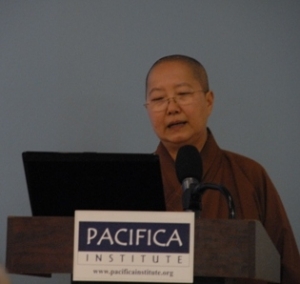Venerable Miao Hsi, a Buddhist monastic ordained in the Fo Guang Shan monastic order, has served as the translator of many of the works of her teacher, Venerable Master Hsing Yun. Venerable Miao Hsi is also the current director of Hsi Lai Temple in Hacienda Heights, CA.
To reflect the growing recognition of the Buddhist tradition in the Western world, Venerable Hsi had decided to entitle her speech: The Dharma Coming West. The title also signified the temple from which she was visiting.
Fo Guang Shan Hsi Lai Temple, a traditional Chinese Buddhist mountain monastery, but located in the local Hacienda Heights, is one of the largest of its kind in the North American continent. Venerable Hsi noted that the name “Hsi Lai” actually means “Coming West” coming to the meaning of “Great Buddha dharma Coming West.”
Miao Hsi delighted her audience as she explained the basics and essentials of the Buddhist faith while also making the listeners smile with her occasional jokes and light-hearted humor. “The ‘Buddha’ means ‘The Enlightened One. The Buddha was enlightened with the truth of universe. ‘Dharma’ means ‘Teaching’ and ‘A Love of the Universe’. ‘Sangha’ means ‘Community’,” she explained. With Hsi’s guidance, the audience walked through the historical background and development of the religion as it grew into where it stands today, with many different forms and practices of Buddhism that people have integrated into their culture and lifestyle, throughout the different parts of the world.
“Buddhism flourished more than 2000 years ago in China, and there are many sources in Chinese. More than a thousand years ago, Japan and Korea sent their monks to China to learn these teachings. They took the teachings back to their countries and they developed it. But the Buddha is the same Buddha. Over the years, the way of practice changed and developed, bringing about their unique schools and forms of Buddhism. That is why we see different kinds of Buddhism today,” she illustrated. Another bit of interesting information was when she touched upon the place of religion within people’s lives throughout its history. “After a while, the religion became very elitist. Either you were very scholarly and academic, or you thought about Buddhism as something for people who died. You would think of a monk only if somebody died in your family, for a religious service.” She explained the reason for this to be the fact that the temples were situated high up in the mountains and would take a day’s travel to reach during those times in history.
Nowadays though, that’s not the case, she noted, as she invited the audience to visit the Hsi Lai on the foothills of Hacienda Heights and experience the life of a devout Buddhist; one full of prayer, chanting and working for the good of the world. Striving for peace, both within the individual and throughout the world, and encompassing all living beings, Venerable Hsi emphasized the embracing approach of the Buddhist tradition and noted that the tradition held no strict boundaries, opening its doors to all.
An interesting Q&A session followed after and was wrapped up with smiles all around. The participants enjoyed a light lunch and friendly conversation well into the afternoon.

